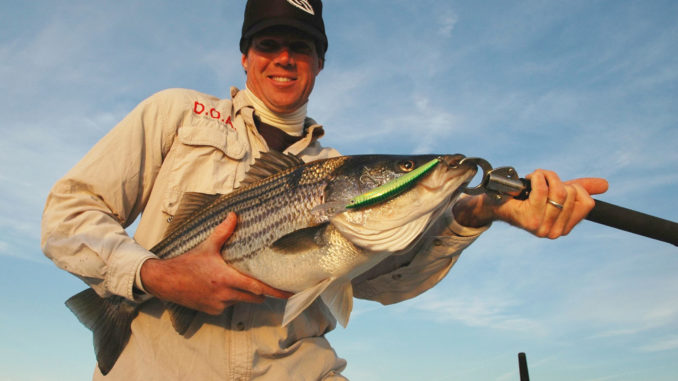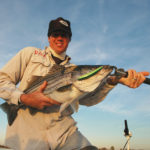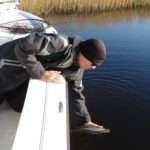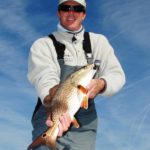
Three rivers around this North Carolina port city hold plenty of fish, and fishing pressure is relatively light. Try these tips and add some new water to your fishing resume.
Anyone travelling around the Wilmington, N.C., area has got to cross at least one of three rivers — the Cape Fear, Northeast Cape Fear and Brunswick — but because very few boats are visible from the bridges across those rivers, fishing is often under the radar for many, which is a terrible mistake.
The rivers provide good fishing year-round, and occasionally, fishermen are treated to one of those, “You had to be there to believe it,” days.
Stuart Caulder of Gold Leader Guide Service specializes in catching the fish that call the area home. One of his favorite places to fish is the area from the I-140 bridges across the Cape Fear and Northeast Cape Fear downstream to the power lines that cross the Cape Fear below the State Ports, an area that includes the full length of the Brunswick River.
“Most of the year, there are trout, reds and flounder in much of the water around Wilmington,” Caulder said. “Flounder fishing begins to slow in the late fall, but the others continue, and stripers arrive in the winter, sometimes by Thanksgiving, and add an extra dimension.”
Stripers can’t be creeled in the Cape Fear, and with cold-stun events causing the N.C. Division of Marine Fisheries to close the keeper season on speckled trout until June 18, those two species are available on a catch-and-release basis only.
“But it’s good fishing all year, with the opportunity to catch some stripers through the winter and spring, and there’s always the potential for a big one,” Caulder said.
The water in the rivers around Wilmington is tidal water, and Caulder said the stage and flow of the tide is important. One morning last March, he launched before daylight at the Dram Tree Park Ramp in downtown Wilmington and motored up the river to a point holding some underwater structure that created a big boil with the moving tide.
Pointing to the boil, Caulder said, “The tide is still rising a little, but it has slowed and will be changing soon. Cast this X-Rap upcurrent of the boil and jig it lightly to get it to dive, but let the current push it across the structure and into the boil. If there are any stripers here, we should know pretty quickly.”
The reaction wasn’t quite immediate, but a hungry striper grabbed the X-Rap on the third cast. It wasn’t a big fish, but it was a good sign, and after a short fight, it was netted and released. A few minutes later, Caulder set the hook on a bigger fish, which rose to the surface and flashed its striped sides in the early morning light several times before tiring and allowing Caulder to lead it to the waiting net.
“I was hoping they would be here this morning,” Caulder said. “Sometimes they move in here when the flow begins to slow leading up to the tide change. This should be good for a little while, but it will slow or maybe stop completely when the tide stops for the change.”
A few casts later, the complexion of the morning changed. A fish hit and bulled its way to the surface, where it lifted its head out of the water and shook, trying to dislodge the lure.
“That’s a trout,” Caulder said, an element of surprise in his voice. “I’ve only caught a few of them here in a bunch of years.”
The next few casts all produced speckled trout; Caulder guessed that bait being pushed past for the specks to hold in the moving water.
When the tide stalled just before beginning to fall, the action ended, and after fishing falling water for a bit, he knew it was time to relocate, heading upriver to a place where several small creeks dumped into the river. He pointed out that the tide had just switched, and water was beginning to flow out of the creeks, carrying some bait, and he set up to fish the area from just inside the creek’s mouth into the river.
“I’ve tied some DOA C.A.L. soft plastics on light jigheads,” Caulder said. “Cast them into the creek and twitch them lightly to bump them off the bottom and let the current push them out. Fish from right along the grass out to the middle of the creek. There should be stripers and red drum here. The drum usually feed very close to the edge, while the stripers might be out in the middle. You’ll know which as soon as you get a strike, because drum will typically run down the bank, and stripers will bolt for open water. I’ll fish this MirrOlure MR 17 to see if they prefer it, and we’ll switch to whichever they like best.
There weren’t any hungry fish in the first creek, but they were waiting and ready in the second. The action was from as far up the creek as you could cast to the drop-off into the channel about 20 feet out into the river.
The key was not fishing quickly and concentrating on popping the lure up off the bottom and letting it flutter back down without moving forward too far. Almost all the strikes came while the bait was dropping, with a few right after it reached the bottom.
The puppy drum and stripers weren’t very particular and liked both baits. Caulder switched to single-hook jerkbaits to make them easier to release. White and pearl sides and a dark back was the color combination they liked best.
At somewhere around half tide, the bite slowed in the creek mouth, but shifted out to the shallow shelf before the drop into deeper water in the river. The fish whacked the lures and took off. Caulder said sometimes they can be like trout and the strike is just a light peck, so he uses braided line and sensitive rods that transmit even the slightest tic up the line to the fisherman.
The mixed-bag fishery around Wilmington is usually good. It can change a little and shift locations with an influx of rainwater runoff or salt water. The good news is that the fish don’t move far and can usually be found. Stripers are usually upriver from the power line that crosses below the State Port, and reds and specks rarely venture upriver beyond the I-140 bridges. Winter fishermen can usually find a few red drum, speckled trout and stripers. Stripers really shine from late February on as they are feeding heavily preparing for their spawning run up the Cape Fear and Northeast Cape Fear Rivers.
DESTINATION INFORMATION
HOW TO GET THERE — Wilmington is the eastern terminus of I-40 and the primary route most people take to get there, although US 74 and US 421 will bring many people from western North Carolina to Wilmington. US 17 is the best north and south route. Public boat ramps include Dram Tree Park on Castle St. next to the Cape Fear Memorial Bridge, on the Northeast Cape Fear River off US 117/NC 133 in Castle Hayne and at Snows Cut in Carolina Beach off US 421. A fee ramp is available at Carolina Beach State Park. Areas downstream of the Cape Fear Memorial Bridge require a saltwater fishing license; a freshwater license is required upstream of the bridge.
WHEN TO GO — Flounder, red drum and speckled trout may be in the waters around Wilmington at any time, depending on whether freshwater runoff has pushed them downstream. Striped bass may be around until May or early June depending on the timing of their spawning run. Trout season is closed until June 15 because of cold-stun kills in January.
TACKLE/TECHNIQUES — Medium-light to medium-heavy, 7-foot spinning outfits will work fine, with reels spooled with braided line and a 1- to 2-foot fluorocarbon leader. Target creek mouths, dock pilings and bridge abutments with large, soft-plastic swimbaits and jerkbaits rigged weedless, plus MirrOlure MirrODine 17 MRs and 27 MRs and Rapala X-Raps. Troll with deep-diving lures, especially around bridges and channel edges.
FISHING INFO/GUIDES — Stu Caulder, Gold Leader Fishing, 910-264-2674; Tex’s Tackle and Bait, 910-791-1763, www.texstackle.com; Island Tackle and Hardware, 910-458-3049, www.islandtacklehardware.com; Intracoastal Angler, 910-392-3500, www.intracoastalangler.com. See also Guides and Charters in Classifieds.
ACCOMMODATIONS — Best Western, Coastline Convention Center, 800-617-7732, www.coastlineinn.com; MainStay Suites, 910-329-1741, www.mainstaywilmington.com; Sleep Inn, 910-313-6665, www.sleepinnwilmingtonnc.com; Cape Fear Convention and Visitors Bureau, 877-406-2356, www.capefear.nc.us.
MAPS — GMCO Chartbook of North Carolina, (888) 420-6277, www.gmcomaps.com; Capt. Segull’s Nautical Charts, 888-473-4855, www.captainsegullcharts.com.







Be the first to comment